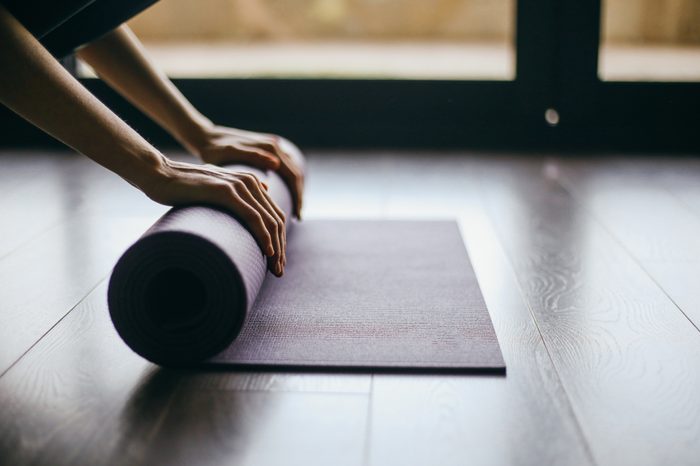
Avoiding weight gain when the gym is closed
If you’re a regular gym-goer, you may still be struggling with settling into a new normal amidst Covid-19-related closures. The good news is whether you were dedicated to your routine or you struggled to make it to the fitness center pre-Covid-19 pandemic, there are practical ways to adapt your workouts to an at-home lifestyle. In fact, maintaining your fitness gains doesn’t require as much effort as you might think. This practical advice can prevent you from losing ground during a gym hiatus, stave off weight gain (or even lose weight), and help you remain healthy and strong.
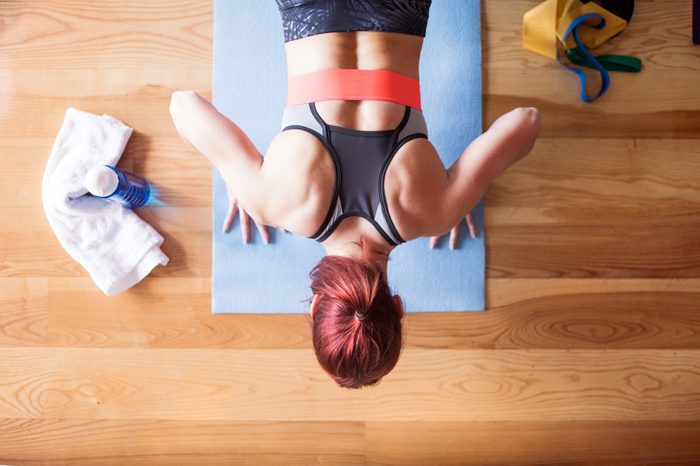
You don’t have to start over
If you’ve lost a little workout time as you’ve adapted during this crisis, don’t worry. Current research suggests it takes a minimum of three weeks of no training to experience a level of significant muscle loss, according to Bill Kwiek, board-certified athletic trainer and Los Angeles-based health and wellness consultant. “It’s surely possible to prevent the loss of fitness gains,” says Kwiek. He adds that with the correct programming and effort, you can not only avoid losses, but actually have gains during this time.
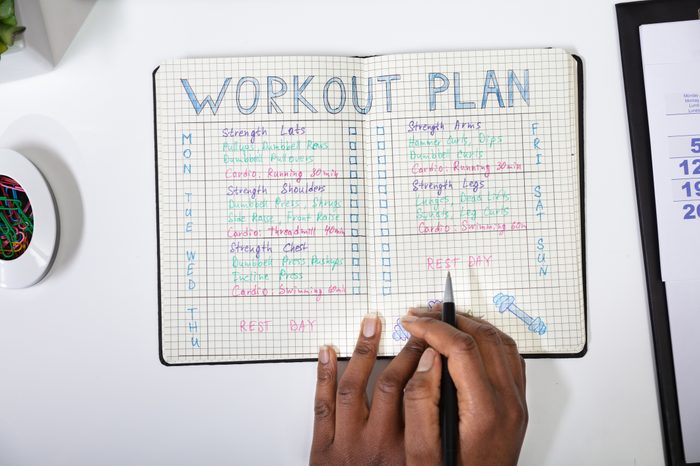
Create a routine
The World Health Organization (WHO) advises that in order to attain the most health benefits from physical activity, adults need at least 150 to 300 minutes of moderate-intensity aerobic activity each week, plus muscle strengthening activities two days per week. One way that can be accomplished is to carve out 30 minutes five days a week, says Erwin Seguia, board-certified specialist in sports physical therapy, and co-founder of Match Fit Performance. One at-home cardio option Seguia suggests is Tabata, a unique research-based work/rest protocol. This workout, created by Japanese scientist Izumi Tabata and his research team from the National Institute of Fitness and Sports in Tokyo, is a type of high-intensity interval training (HIIT). For example, Seguia says a Tabata session includes eight rounds of 20-second exercises at maximum effort, with 10 seconds of rest in between. Kwiek also emphasizes giving your body proper rest time after workouts, in order to recover and adapt, which helps support performance improvements and fitness results.
(Looking for motivation? Check out these amazing weight loss before-and-after photos.)
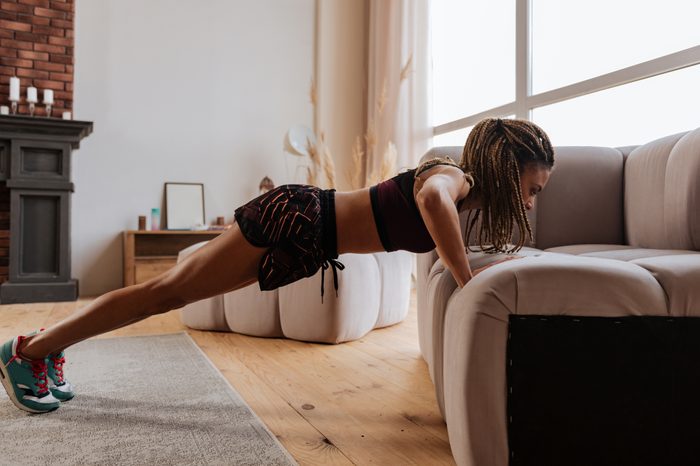
No equipment needed
“There is a plethora of free body-only home workouts available via social media and personal trainers during this time,” says Kwiek. You can also schedule one-on-one sessions with fitness experts via FaceTime, or hire a professional to create a personalized program based on your goals and the equipment you may have at home. Seguia doesn’t believe there’s a one-size-fits-all approach. But a general guideline is to engage in two to three strength training sessions per week using your own body weight. This routine can include a sit to stand move (squat) and step up/down (walking up/down stairs with minimal support) for your lower body, in addition to a push (shoulder press, bench press, or bench dip), and a pull (like a bent over row or bench row) for your upper body. If you don’t have free weights, household items like cans, bags filled with books, water jugs, and rice bags can provide extra weight.
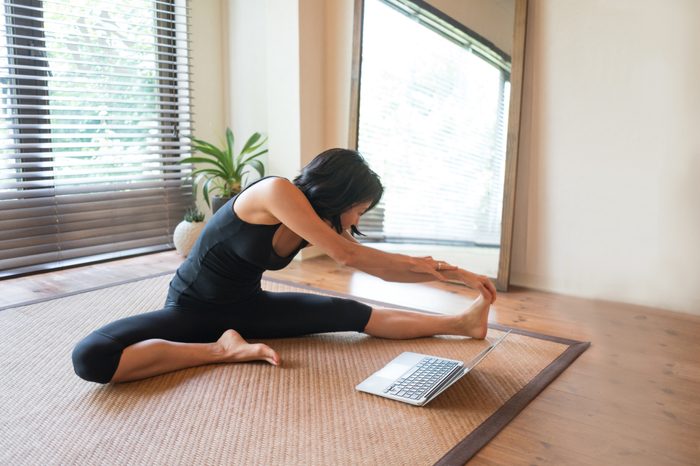
Evaluate online workouts carefully
A top priority at this time is exercising safely. This is to ensure you don’t need to worry about seeking a doctor’s care for a fitness-related injury. Before engaging in any workout you run across online, run it through a few filters. “The key to exercising at home safely is not to exceed or change the load you normally put on your body,” says Kwiek. For example, if you typically don’t do long runs as part of your gym program, it is not a good idea to start doing multiple mile runs daily now that you are at home, says Kwiek. And if you’re engaging in any new fitness activities at home, Kwiek advises to start at the novice level, and slowly progress as your body adapts. Seguia says, “If you’re doing an exercise for the first time, and anything in the movement feels sharp or stabbing or becomes uncomfortable enough that you have to change the way you’re doing it, it’s time to stop.” Kwiek also recommends common-sense safety measures, including exercising on safe surfaces, and not jumping or landing on hardwood floors wearing socks. (Also, you might want to make post-workout stretching a priority.)

Take advantage of this opportunity
If your workout routine has been spotty in the past, being at home can be the perfect time to develop a ritual, which can ultimately help you prevent weight gain, or even improve your body composition. Kwiek says, “This might be a once in a lifetime opportunity to start a more consistent workout routine.” He adds that the top excuse for lack of exercise is not having enough time. With that barrier overcome, now that daily commutes, kids’ activities, and other outside obligations are on hold, this is an ideal chance to establish a schedule. Kwiek recommends physically writing down and scheduling exercise into your week. In his experience, this practice can improve the likelihood that you will hold yourself accountable. Committing to a workout buddy, either in your own home, or who you share your progress with via calls, texts, or social media, is also a smart accountability strategy, advises Seguia. He adds, “Habit building is hard, but it’s not impossible.”

Aim for nutritional balance
In addition to exercise, healthy eating plays a major role in preventing weight gain. As a registered dietitian, in my practice, I find that nutrition contributes to roughly 80 percent of weight management outcomes and exercise 20 percent. That’s because the number of calories burned during exercise generally can’t compensate for a pattern of overeating. For example, according to the Centers for Disease Control and Prevention, a 154-pound man burns 280 calories walking at 3.5 miles per hour for 60 minutes. Keep in mind, a pint of Ben & Jerry’s Cherry Garcia provides 1010 calories.
You don’t have to banish your favourite treats, but try to enjoy them mindfully less often rather than spontaneously on the daily. Aim for balanced meals comprised of plenty of produce, lean protein, healthful fat, and moderate portions of fibre-rich carbohydrates, including whole grains, starchy vegetables, and fruit. Fortunately, research shows that regular exercise naturally drives healthier eating. For example, in a 2015 study published in the Journal of the American College of Nutrition, researchers found that in young adults, established exercise habits led to improved fruit and vegetable consumption. (Check out these simple tips to freeze fresh food.)
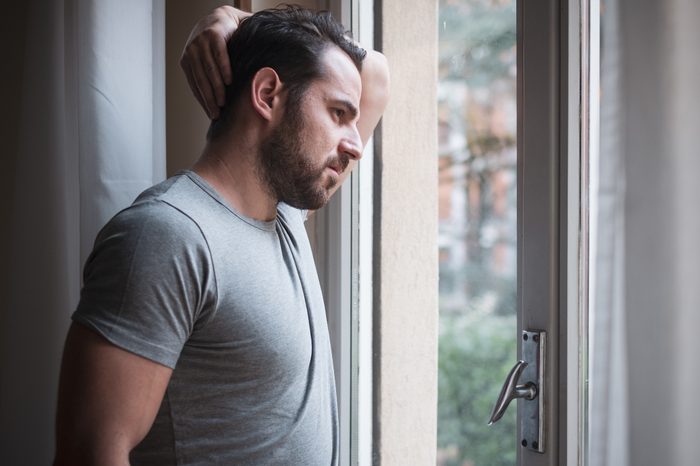
Don’t give up
Lastly, if you’re tempted to take a break from exercise until restrictions are lifted, there are important reasons to hang in there. “Exercise and regular movement help with immunity, digestion, and other bodily functions,” says Seguia, who gently reminds that our bodies are made to move. He adds that even pacing, walk in your apartment, or walking up and down steps, offers benefits over sitting. Kwiek adds that being active has also been shown to increase energy and mood, reduce stress, and improve cognitive function. “Exercise is an easy way to maintain your best physical and mental health during this uncertain time,” says Kwiek.
Set up a routine, choose safe workouts that match your fitness level, and build in some accountability. The benefits are impactful immediately and may help you establish a healthy habit with staying power long beyond this pandemic.
Next, read up on the best streaming workouts for women.
